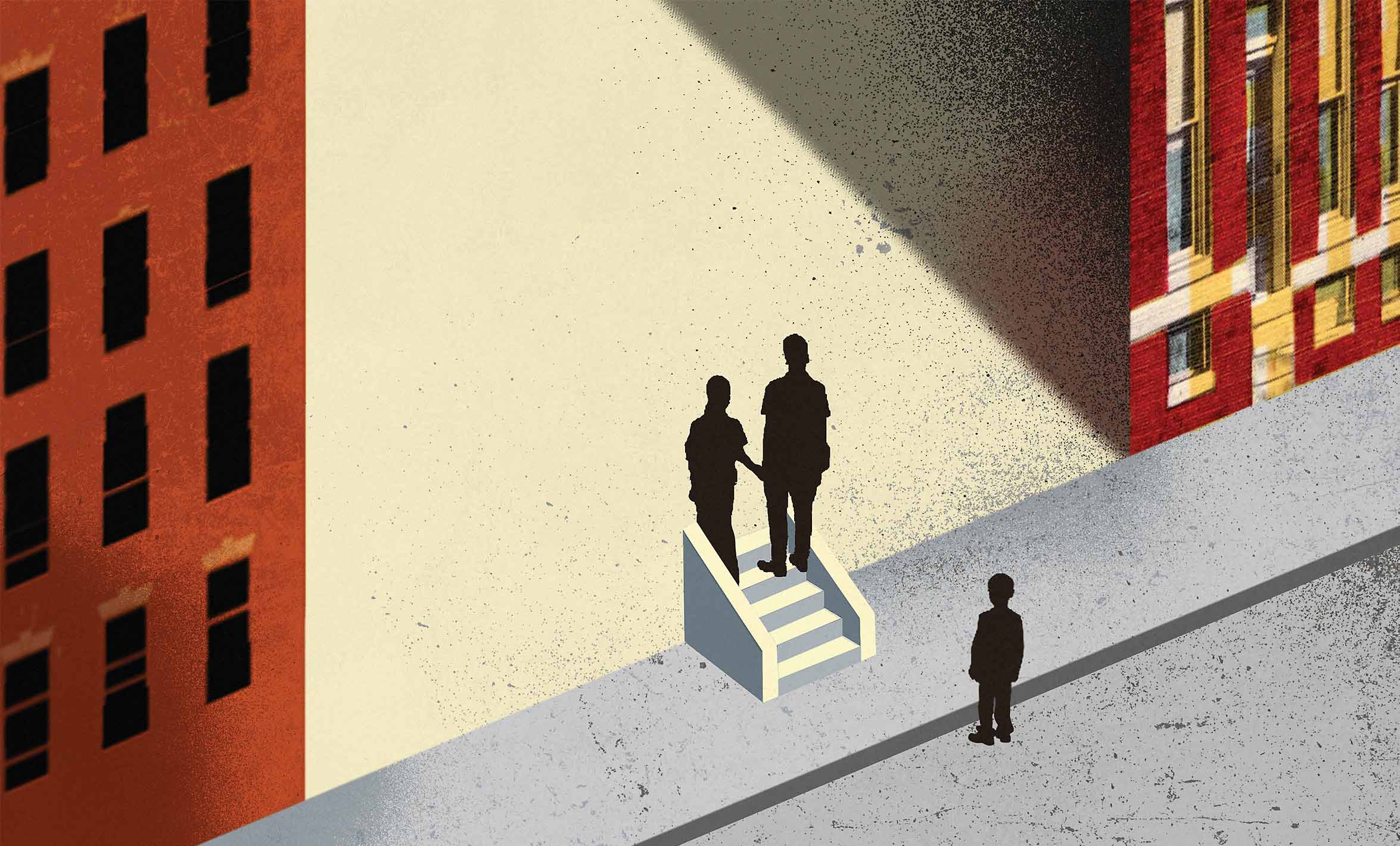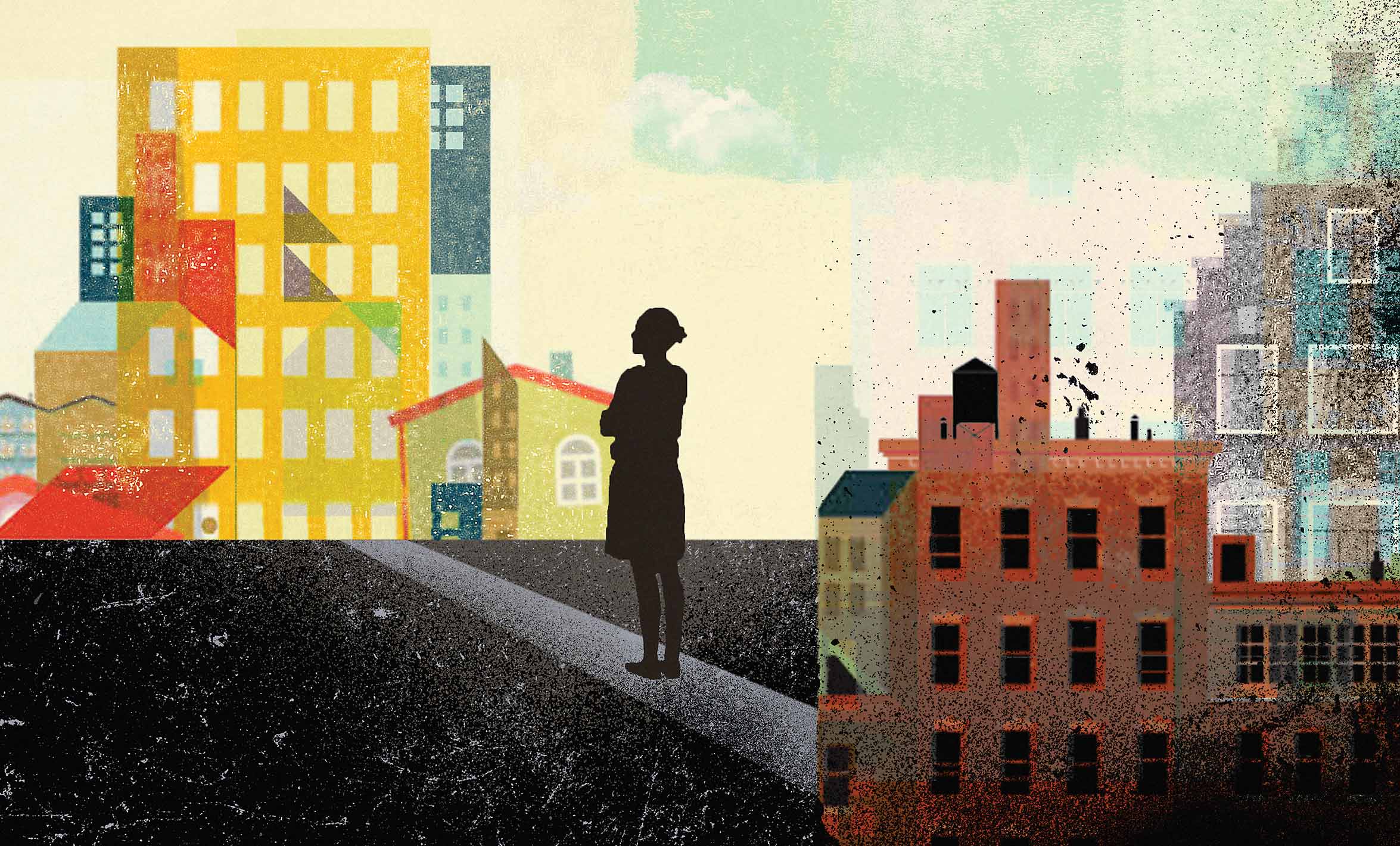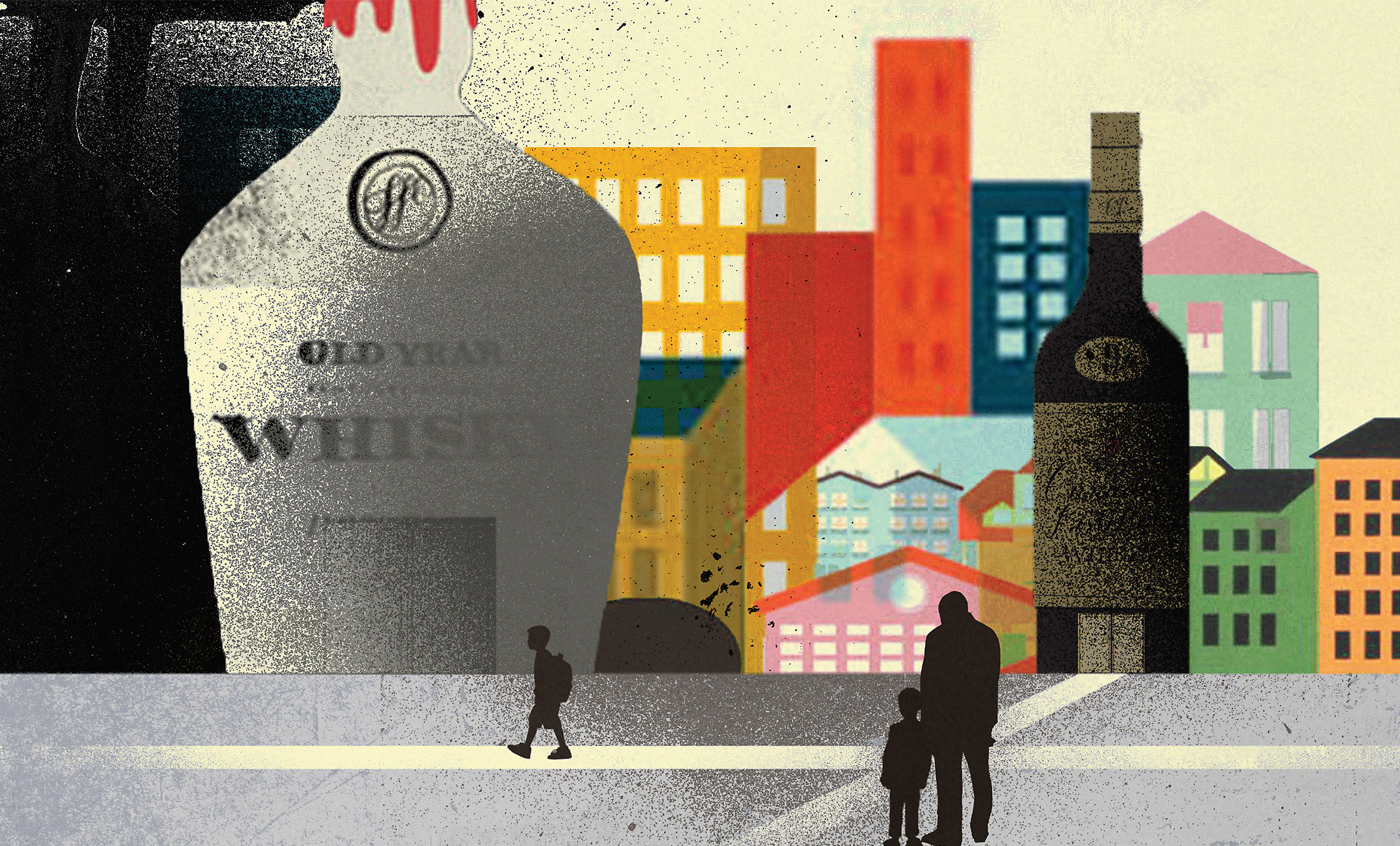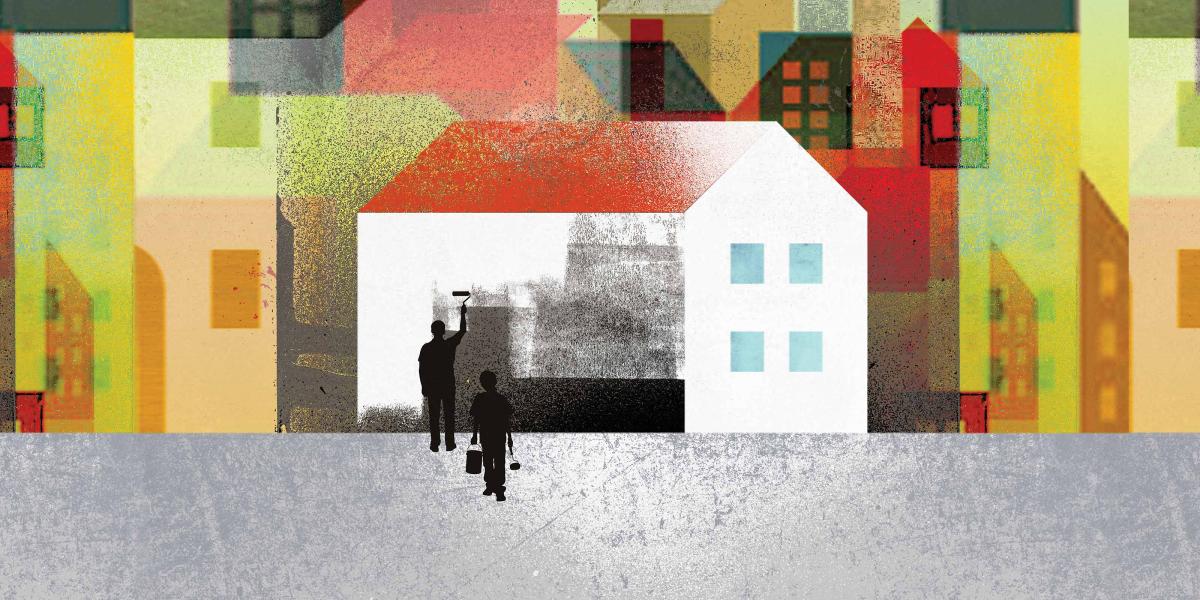Housing and Health: What Science Has Learned about the Importance of Home
An exploration of one of our most basic needs—and what failing to meet it means.
Home is everything.
It’s where we shelter from the world, take our first steps, and learn about life. Home shapes who we are, and then we shape it to reflect who we have become. Home runs deep in our identity as human beings. It is the refuge where we sleep and dream.
And, our home largely determines our health. The water we drink, the air we breathe, the security we feel—all start at home. For the fortunate, home is where we thrive. For others, home is a roomful of risks or a memory carried on the streets.
What has science learned about health and home?

Young Minds, Big Burden
Gauging eviction’s impact on children.
After Natasha Perry lost her job and her unemployment insurance expired, she and her five children were evicted. “I felt like I had brought these innocent kids into this world and couldn’t give them what they deserved,” Perry says.
Her 11-year-old daughter, Unique Lloyd, couldn’t shake the feeling that “bad things are going to happen.” The constant worry triggered headaches, and her grades at school slumped.
Perry later found work at a Catholic Charities’ family shelter in central Maryland where she had stayed before moving into a new home. Unique volunteers there, letting children know “they’re not alone.”
Too many children face similar trauma, says Kate Leifheit, MSPH ’14, who is studying eviction’s impact on child health.
Among thousands of studies on eviction, Leifheit was surprised that she could find only one paper on her topic. For the PhD candidate in Epidemiology, it’s a tragic knowledge gap, given that households with children are more likely to be threatened by eviction.
Her dissertation tackles essential questions: How do eviction rates of low-income families with children differ from those of other families with children? Are there links between eviction and chronic conditions like childhood obesity and poor cognitive development? Does eviction disrupt access to federal food programs?
Working with experts in child health, epidemiology, and housing policy, Leifheit is sifting data from large studies that provide a longitudinal look at the development of children in low-income families struggling with housing costs.
A disproportionate number of children who experience eviction come from communities of color, in large part because structural racism has thwarted homeownership and made safe, affordable housing increasingly rare, Leifheit says. The people who get evicted are already the most vulnerable and marginalized, she says. “Eviction is harmful enough, but it’s largely affecting people who are already struggling to get by,” Leifheit says.
If the rise in evictions does not cause concern among the public or policymakers in and of itself, data showing that eviction can disrupt children’s cognitive development and promote malnutrition could be a more persuasive tool, she says.
“You can add on a layer and say it’s making children sick. That’s something people have to listen to,” Leifheit says.
"The most prevalent housing problem affecting the healthy development of millions of low- and moderate-income children is ... the portion of a household's income spent on housing."
—Sandra Newman, PhD, Professor, Institute for Health and Social Policy
Young, Homeless, and Seeking Safe Shelter
“There’s no such thing as a calm day at a shelter,” says Jasmine S. Calhoun, a Bloomberg American Health Initiative fellow who directs the Innerlink Runaway and Homeless Youth Shelter in Saginaw, Michigan.
-
What causes most youth homelessness?
I’ve seen a lot of youth who identify as LGBTQ who get put out of their homes. And youth aging out of foster care are a huge portion of our population. They’re usually given a small bag of their belongings and told to figure it out. -
What do most people not understand about homeless youth
Most people don’t really understand how much of a problem it is. A lot of the kids are couch surfing. They’re going from an aunt’s house to a grandmother, a friend, a teacher … . People have to understand that housing instability is homelessness. -
What are the hardest parts of your job?
You see so much potential in these kids, and you have the resources and the skills to help them. That’s the hardest thing, knowing what kind of potential they have, but also knowing that they have to be an active player in their own lives.

Should I Stay or Should I Go?
Tough choice: Remain in revitalized area or relocate?
When they moved from seven of Atlanta’s most decrepit public housing complexes, African American residents left behind the threat of violence and connections with substance users.
The 172 adults—mostly women and predominately substance users themselves—were followed by Sabriya Linton, PhD ’13, MPH, and her colleagues at Emory University as they moved to voucher-subsidized rentals in less impoverished neighborhoods. Over time, they lost touch with their old social circles. Their drug use subsided, and their non-monogamous sexual partnerships declined.
Still, relocation isn’t necessarily preferable, says Linton, an assistant professor in Mental Health.
In a 2013 study, Linton asked people with a history of injection drug use how they were affected by the East Baltimore Development Inc. redevelopment project that had displaced hundreds of homeowners and tenants.
“Some people said it helped their recovery,” Linton says. But there were caveats: Respondents said they couldn’t get jobs related to the redevelopment project or afford new rental units in the redeveloped area.
Her study argued for redevelopment strategies that expand the stock of affordable, quality housing and the right of residents to return to their neighborhoods. And it presented a question she still wrestles with: “How can we increase equity and ensure that historical residents benefit from economic development that occurs in their neighborhood if they relocate or are displaced from it?”
Linton is now evaluating the merits of simultaneously rolling out a housing voucher program and an urban revitalization project. Funded by HUD, the Choice Neighborhoods Initiative will give residents of a Baltimore public housing project the option to stay in what will become a mixed-income community or receive vouchers for subsidized housing elsewhere.
Her study will compare the options as strategies for reducing substance use disorders and other harmful behaviors. Each poses potential risks. “Resource-poor, urban communities might be seen as having deficits, but they also have assets, such as tight social networks with neighbors sharing resources,” Linton says.
When people relocate, that social fabric is lost, she says.
VOUCHERS FOR HEALTH
The many benefits of housing assistance.
Craig Pollack thinks housing vouchers can be a valuable public health tool. They can help residents access safe homes, healthy food, green space, and better jobs, says Pollack, MD, MHS, MSc, an associate professor in Health Policy and Management.
-
Do housing vouchers improve health?
Far too many families spend too much of their income on housing and have to cut back on fresh food, medical care, and other needs. Housing vouchers are one tool to help reduce housing costs for low-income families; they may lead to better health and lower health care spending. -
Do policymakers understand their value?
There’s increasing recognition that housing and health are inextricably linked. With some health systems starting to routinely screen their patients for the social determinants of health and with payers moving toward paying for value, there is a window of opportunity for policymakers and practitioners to work together to develop innovative solutions. -
What’s your hope for the future?
Ultimately, we need to work to increase the availability of affordable housing and better link our housing and health systems. On this road, there is a need for research that, for example, examines the health impact on priority populations and better understands the neighborhood context.
A CAPABLE TEAM—WITH A HANDYMAN—CAN HELP SENIORS STAY SAFE AT HOME
The Vietnam veteran no longer left his home—except for dialysis.
In a wheelchair and suffering from constant pain and depression, he had modest goals: To stand as he shaved and to reach his back steps to birdwatch.
A program called Community Aging in Place—Advancing Better Living for Elders helped. CAPABLE nurses guided his pain management and helped him improve his balance. A handy worker installed a grab bar in the bathroom so the veteran could shave on his feet.
“He now goes into the community and does things. That’s a huge, huge change,” says Sarah Szanton, PhD, ANP. Szanton developed the program with colleagues after making house calls as a nurse to elderly residents in low-income communities, where slippery tubs, shaky bannisters, and broken flooring created risks.
Home is where the needs of older adults are best addressed, says Szanton, director of the Center for Innovative Care at the School of Nursing with a joint appointment in Health Policy and Management. “If you had seen the veteran in a clinic in that much pain, you really wouldn’t know how to help him,” she says.
Funded by Medicaid, private foundations, and other sources, more than 25 CAPABLE sites operate across the country. An HHS advisory panel has recommended Medicare coverage of CAPABLE.

The Liquor Store Next Door
Zoning codes can support the health of neighborhoods—and residents.
When Baltimore City began revising its zoning code in 2007, Rachel Thornton saw an opportunity.
With Bloomberg School students and other researchers, Thornton, MD, PhD ’04, conducted a health impact assessment of proposed changes to the code. Amid the positive changes—more mixed-use development and pedestrian-friendly design—one problem stood out: liquor stores.
A disproportionate number of liquor stores already clustered in Baltimore’s poorest neighborhoods. Thornton and her team cited studies that linked high liquor store density to violent crime and poor health outcomes.
They also identified opportunities to use zoning to address alcohol outlet density while advancing public health and health equity.
When the Baltimore City Council approved the new zoning code in 2017, it incorporated provisions to reduce liquor store density—influenced in part by the work of Thornton and her colleagues.
Thornton, an associate professor at the School of Medicine with a joint appointment in Health, Behavior and Society, is now monitoring the impact of these provisions. While the data linking alcohol outlets and public health harms are clear, the story for communities is more nuanced. For example, community members have voiced concerns that the policy could exacerbate inequities as liquor stores may meet other needs, such as access to food and opportunities for social interaction.
“It may not be as simple as you close a liquor store, and crime gets better and life improves in a given community,” Thornton says.
Creating policies that alleviate potential harms and promote positive development and neighborhood renewal requires a deep understanding of interdependent factors, including the “lived experiences” of community residents, she says.
"Asthma is a major public health problem among low-income children in urban neighborhoods."
—Craig Pollack, MD, MHS, MSc, associate professor in Health Policy and Management
Breathing It In
Can a change of address improve asthma outcomes?
With leaks, cracks, and inadequate ventilation, substandard housing provides ideal conditions for allergens from rodents, cockroaches, and mold. The link between such housing and asthma has been well documented. So has the disproportionate prevalence of asthma among low-income children living in these settings.
Less is known, though, about how our home environment affects our microbiota—the bacterial and fungal colonies that populate our bodies—and how airway microbiota may contribute to asthma. Meghan Davis, DVM, PhD ’12, MPH ’08, is exploring those connections to determine whether moving to a healthier environment changes the microbial composition in children’s airways and reduces kids’ asthma symptoms as a result.
“We hope to use this as an opportunity to better understand how microbial profiles change the way asthma manifests in kids who already have allergic asthma,” Davis says.
Through the Baltimore Housing Mobility Program, the assistant professor in Environmental Health and Engineering is tracking children with asthma who move from high-poverty, urban neighborhoods to low-poverty, suburban communities. Every six months, her team takes swabs of children’s airways to see if microbial content changes when a family moves. They also take samples of dust in the former and new homes to see if there may be a connection between the home environment and any changes in the children’s microbiota. Changes in asthma symptoms will be tracked to identify potential links to airway microbiota.
The study will produce evidence that researchers can use to identify connections among the environment, airway microbiota, and asthma. Davis’s findings may also bring a vital new dimension to conversations among policymakers and advocates on the benefits of relocating low-income households to healthier homes.
